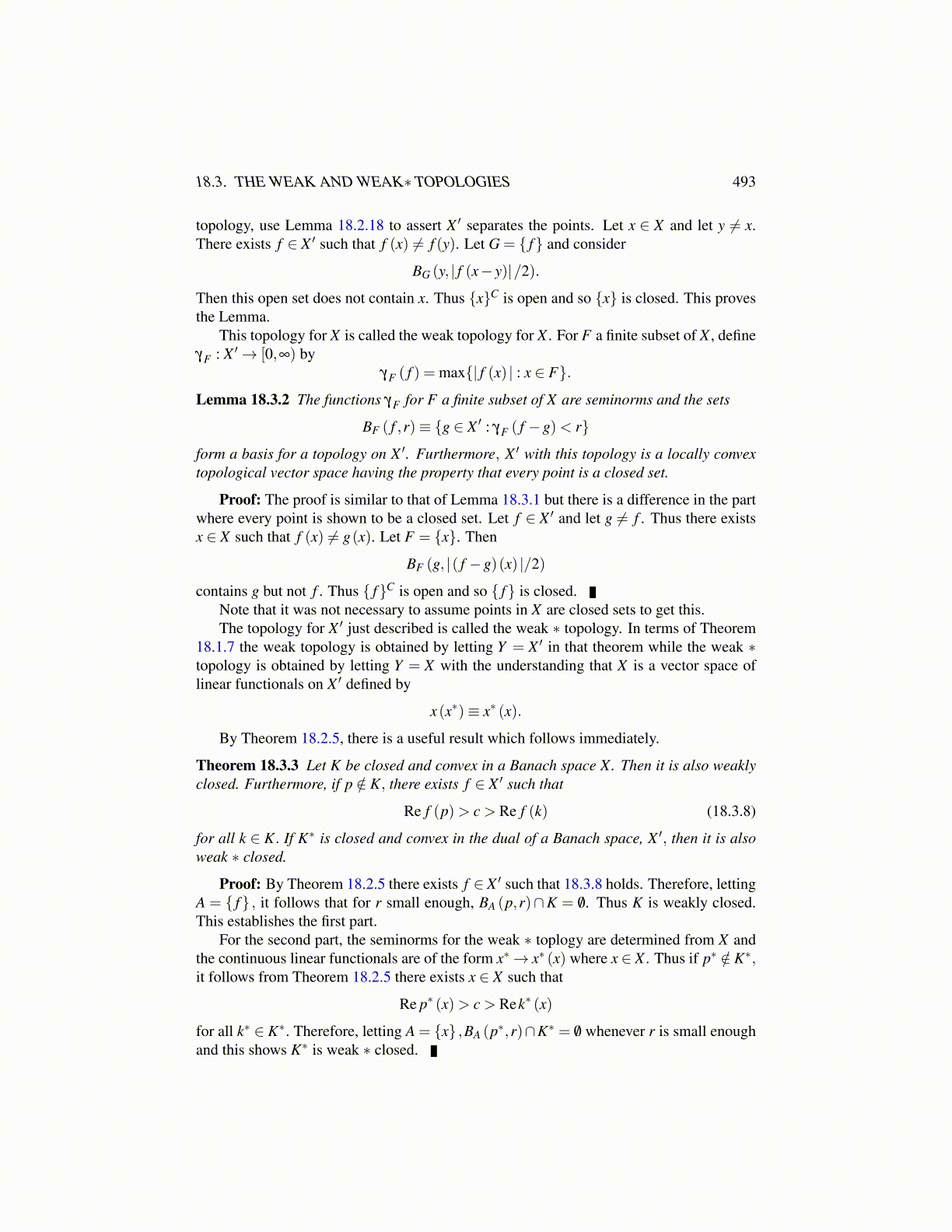
18.3. THE WEAK AND WEAK∗ TOPOLOGIES 493
topology, use Lemma 18.2.18 to assert X ′ separates the points. Let x ∈ X and let y ̸= x.There exists f ∈ X ′ such that f (x) ̸= f (y). Let G = { f} and consider
BG (y, | f (x− y)|/2).
Then this open set does not contain x. Thus {x}C is open and so {x} is closed. This provesthe Lemma.
This topology for X is called the weak topology for X . For F a finite subset of X , defineγF : X ′→ [0,∞) by
γF ( f ) = max{| f (x) | : x ∈ F}.
Lemma 18.3.2 The functions γF for F a finite subset of X are seminorms and the sets
BF ( f ,r)≡ {g ∈ X ′ : γF ( f −g)< r}
form a basis for a topology on X ′. Furthermore, X ′ with this topology is a locally convextopological vector space having the property that every point is a closed set.
Proof: The proof is similar to that of Lemma 18.3.1 but there is a difference in the partwhere every point is shown to be a closed set. Let f ∈ X ′ and let g ̸= f . Thus there existsx ∈ X such that f (x) ̸= g(x). Let F = {x}. Then
BF (g, |( f −g)(x) |/2)
contains g but not f . Thus { f}C is open and so { f} is closed.Note that it was not necessary to assume points in X are closed sets to get this.The topology for X ′ just described is called the weak ∗ topology. In terms of Theorem
18.1.7 the weak topology is obtained by letting Y = X ′ in that theorem while the weak ∗topology is obtained by letting Y = X with the understanding that X is a vector space oflinear functionals on X ′ defined by
x(x∗)≡ x∗ (x).
By Theorem 18.2.5, there is a useful result which follows immediately.
Theorem 18.3.3 Let K be closed and convex in a Banach space X. Then it is also weaklyclosed. Furthermore, if p /∈ K, there exists f ∈ X ′ such that
Re f (p)> c > Re f (k) (18.3.8)
for all k ∈ K. If K∗ is closed and convex in the dual of a Banach space, X ′, then it is alsoweak ∗ closed.
Proof: By Theorem 18.2.5 there exists f ∈ X ′ such that 18.3.8 holds. Therefore, lettingA = { f} , it follows that for r small enough, BA (p,r)∩K = /0. Thus K is weakly closed.This establishes the first part.
For the second part, the seminorms for the weak ∗ toplogy are determined from X andthe continuous linear functionals are of the form x∗→ x∗ (x) where x ∈ X . Thus if p∗ /∈ K∗,it follows from Theorem 18.2.5 there exists x ∈ X such that
Re p∗ (x)> c > Rek∗ (x)
for all k∗ ∈ K∗. Therefore, letting A = {x} ,BA (p∗,r)∩K∗ = /0 whenever r is small enoughand this shows K∗ is weak ∗ closed.